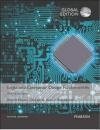Logic and Computer Design Fundamentals
Tom Martin, Charles Kime, Morris Mano
Logic and Computer Design Fundamentals
Tom Martin, Charles Kime, Morris Mano
- Producent: Pearson
- Rok produkcji: 2015
- ISBN: 9781292096070
- Ilość stron: 672
- Oprawa: Miękka
Niedostępna
Opis: Logic and Computer Design Fundamentals - Tom Martin, Charles Kime, Morris Mano
For courses in Logic and Computer design. Understanding Logic and Computer Design for All Audiences Logic and Computer Design Fundamentals is a thoroughly up-to-date text that makes logic design, digital system design, and computer design available to students of all levels. The Fifth Edition brings this widely recognized source to modern standards by ensuring that all information is relevant and contemporary. The material focuses on industry trends and successfully bridges the gap between the much higher levels of abstraction students in the field must work with today than in the past. Broadly covering logic and computer design, Logic and Computer Design Fundamentals is a flexibly organized source material that allows instructors to tailor its use to a wide range of student audiences.1. Digital Systems and Information 1-1 Information Representation 1-2 Abstraction Layers in Computer Systems Design 1-3 Number Systems 1-4 Arithmetic Operations 1-5 Decimal Codes 1-6 Alphanumeric Codes 1-7 Gray Codes 1-8 Chapter Summary 2. Combinational Logic Circuits 2-1 Binary Logic and Gates 2-2 Boolean Algebra 2-3 Standard Forms 2-4 Two-Level Circuit Optimization 2-5 Map Manipulation 2-6 Exclusive-OR Operator and Gates 2-7 Gate Propagation Delay 2-8 Hardware Description Languages Overview 2-9 HDL Representations-VHDL 2-10 HDL Represenations-Verilog 2-11 Chapter Summary 3. Combinational Logic Design 3-1 Beginning Hierarchical Design 3-2 Technology Mapping 3-3 Combinational Functional Blocks 3-4 Rudimentary Logic Functions 3-5 Decoding 3-6 Encoding 3-7 Selecting 3-8 Iterative Combinational Circuits 3-9 Binary Adders 3-10 Binary Subtraction 3-11 Binary Adder-Subtractors 3-12 Other Arithmetic Functions 3-13 Chapter Summary 4. Sequential Circuits 4-1 Sequential Circuit Definitions 4-2 Latches 4-3 Flip-Flops 4-4 Sequential Circuit Analysis 4-5 Sequential Circuit Design 4-6 State-machine Diagrams and Applications 4-7 HDL Representation for Sequential Circuits-VHDL 4-8 HDL Representation for Sequential Circuits-Verilog 4-9 Flip-Flop Timing 4-10 Sequential Circuit Timing 4-11 Asynchronous Interactions 4-12 Synchronization and Metastability 4-13 Synchronous Circuit Pitfalls 4-14 Chapter Summary 5. Digital Hardware Implementation 5-1 The Design Space 5-2 Programmable Implementation Technologies 5-3 Chapter Summary 6. Registers and Register Transfers 6-1 Registers and Load Enable 6-2 Register Transfers 6-3 Register Transfer Operations 6-4 Register Transfers in VHDL and Verilog 6-5 Microoperations 6-6 Microoperations on a Single Register 6-7 Register-Cell Design 6-8 Multiplexer and Bus-Baed Transfers for Multiple Registers 6-9 Serial Transfer and Microoperations 6-10 Control of Register Transfers 6-11 HDL Representation for Shift Registers and Counters-VHDL 6-12 HDL Representation for Shift Registers and Counters-Verilog 6-13 Microprogrammed Control 6-15 Chapter Summary 7. Memory Basics 7-1 Memory Definitions 7-2 Random-Access Memory 7-3 SRAM Integrated Circuits 7-4 Array of SRAM ICs 7-5 DRAM ICs 7-6 DRAM Types 7-7 Arrays of Dynamic RAM ICs 7-8 Chapter Summary 8. Computer Design Basics 8-1 Computer Design Basics 8-2 Datapaths 8-3 The Arithmetic/Logic Unit 8-4 The Shifter 8-5 Datapath Representation 8-6 The Control Word 8-7 A Simple Computer Architecture 8-8 Single-Cycle Hardwired Control 8-9 Multiple-Cycle Hardwired Control 8-10 Chapter Summary 9. Instruction Set Architecture 9-1 Computer Architecture Concepts 9-2 Operand Addressing 9-3 Addressing Modes 9-4 Instruction Set Architectures 9-5 Data-Transfer Instructions 9-6 Data-Manipulation Instructions 9-7 Floating-Point Computations 9-8 Program Control Instructions 9-9 Program Interrupt 9-10 Chapter Summary 10. RISC and CISC Processors 10-1 Pipelined Datapath 10-2 Pipelined Control 10-3 The Reduced Instruction Set Computer 10-4 The Complex Instruction Set Computer 10-5 More on Design 10-6 Chapter Summary 11. Input-Output and Communication 11-1 Computer I/O 11-2 Sample Peripherals 11-3 I/O Interfaces 11-4 Serial Communication 11-5 Modes of Transfer 11-6 Priority Interrupt 11-7 Direct Memory Access 11-8 Chapter Summary 12. Memory Systems 12-1 Memory Hierarchy 12-2 Locality of Reference 12-3 Cache Memory 12-4 Virtual Memory 12-5 Chapter Summary
Producent:
GPSR Pearson Central Europe Sp. z o.o.
ul. Szamocka 8
01-748 Warszawa (PL)
tel: 459 596 060
email: [email protected]
Szczegóły: Logic and Computer Design Fundamentals - Tom Martin, Charles Kime, Morris Mano
Tytuł: Logic and Computer Design Fundamentals
Autor: Tom Martin, Charles Kime, Morris Mano
Producent: Pearson
ISBN: 9781292096070
Rok produkcji: 2015
Ilość stron: 672
Oprawa: Miękka
Waga: 0.87 kg






























